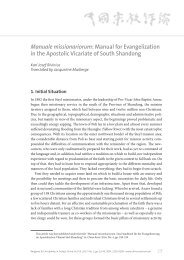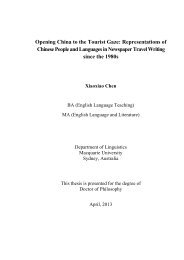EDUCATION IN CHINA
Education-in-China-a-snapshot
Education-in-China-a-snapshot
Create successful ePaper yourself
Turn your PDF publications into a flip-book with our unique Google optimized e-Paper software.
Chapter 2 – Educational reforms and current issues<br />
covers not only students, but also teachers and schools.<br />
The New Curriculum Reform formally entered the stage<br />
of implementation in 2001 in 38 areas and by 2005<br />
all schools nationwide were studying under the new<br />
curricula (Hongbiao, 2013). The new evaluation system is<br />
a departure from the former system, which only counted<br />
students’ academic grades. The new system relies on<br />
diverse criteria for student outcomes, thus changing the<br />
examination-oriented study mode to reduce the burden of<br />
the students. The vision for this new assessment system<br />
is that it should help students discover and develop<br />
their potentials, as well as understand themselves and<br />
build self-confidence. The evaluation system should<br />
also help teachers analyse and improve their teaching<br />
skills. Periodic review of curriculum implementation<br />
and analysis of problems met during implementation is<br />
required by the new evaluation system in order to help<br />
schools improve the curriculum system.<br />
Reducing the role of standardised testing and reforming<br />
the gaokao<br />
The National College Entrance Examination, also known<br />
as gaokao, is also undergoing major changes. The State<br />
Council published official guidelines in 2014 to reform<br />
the gaokao system. Reforms of examinations at different<br />
levels have been developed as well to reduce the influence<br />
of standardised tests. This reform of examinations aims<br />
to establish a modern examination system composed of<br />
standardised tests, comprehensive evaluation and assorted<br />
admissions criteria. It also aims to promote the reform of<br />
the education system as a whole. Shanghai and Zhejiang<br />
province are going to be the pilot experimental regions of<br />
the new system, as agreed with the central government.<br />
Both provinces have developed their own plans to carry<br />
out this reform. Several other provinces and municipalities<br />
have also announced their own reform plans for the<br />
gaokao, including Beijing, Jiangsu and Guangdong.<br />
MA<strong>IN</strong> MEASURES TO REDUCE<br />
THE <strong>IN</strong>FLUENCE OF STANDARDISED TESTS<br />
AT ALL LEVELS<br />
This reform involves entrance examinations at all levels.<br />
Its provisions are described below.<br />
First, authorities of a given region must provide<br />
compulsory education to children who are residents of<br />
this region. Compulsory education may not be contingent<br />
on entrance examinations.<br />
This policy aims at solving the school-selection problem<br />
effectively, especially in urban areas. It requires that<br />
local governments explore multiple measures in order<br />
to guarantee the neighbourhood attendance policy. Such<br />
measures include providing students direct transition from<br />
primary school to junior secondary school, reasonable<br />
division of school districts in which students can enrol<br />
in junior secondary school directly and establishing new<br />
schools that provide nine-year education if possible.<br />
Second, promote the reform of senior secondary school<br />
entrance examinations by establishing a new evaluation<br />
system.<br />
This reform covers the improvement of the academic<br />
proficiency test system and comprehensive evaluation<br />
system, and encourages local governments to explore<br />
enrolment methods based on these systems for senior<br />
secondary schools. It also advises secondary vocational<br />
schools to enrol students based on their academic<br />
proficiency test results.<br />
Third, improve and normalise the academic proficiency<br />
test and the comprehensive attribute evaluation system<br />
for senior secondary schools.<br />
Fourth, establish a new examination and enrolment<br />
system for higher vocational education.<br />
The government wants to reform the higher education<br />
admissions process by separating the examination<br />
and enrolment systems at vocational colleges and<br />
universities. The new examination for higher vocational<br />
education will consist of a part that covers material on<br />
the general exam and a part on specialised skills.<br />
Fifth, reform the gaokao system, and try to establish<br />
a system with comprehensive evaluation and diverse<br />
enrolment mechanisms.<br />
The new gaokao is structured differently than former<br />
examinations. Instead of testing students on two broadly<br />
defined subjects (art and science), the new test will be<br />
structured as a general examination. The new examination<br />
and enrolment system will consist of two parts. One is<br />
the national unified exam, which will test students on<br />
Chinese, mathematics and foreign language. The other is<br />
the academic proficiency test that covers various other<br />
disciplines. For the academic proficiency test, students<br />
can choose the disciplines according to their interests. The<br />
disciplines students choose will be relevant to their majors<br />
when applying for university admissions.<br />
Sixth, establish a graduate programme entrance exam<br />
that can select innovative talents and can sufficiently<br />
test proficiency in high-level applied science.<br />
<strong>EDUCATION</strong> <strong>IN</strong> CH<strong>IN</strong>A: A SNAPSHOT © OECD 2016 – 31





